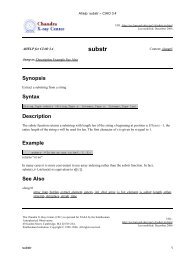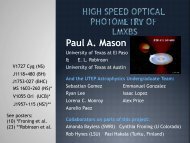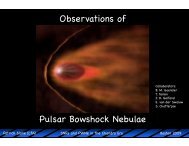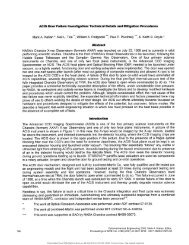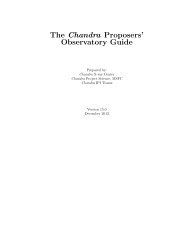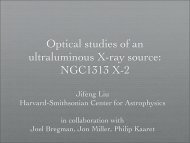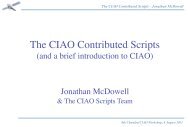Paper Title - Chandra X-Ray Observatory (CXC)
Paper Title - Chandra X-Ray Observatory (CXC)
Paper Title - Chandra X-Ray Observatory (CXC)
Create successful ePaper yourself
Turn your PDF publications into a flip-book with our unique Google optimized e-Paper software.
Re-plans must take into account the requested turn around time, maneuvers required to reach the new<br />
target, spacecraft constraints, communications times and the time required to build and review a new set of<br />
products. Due to on-board memory allocation the weekly loads are divided into smaller load segments,<br />
generally lasting approximately a day and a half. Re-planning a running load segment requires stopping<br />
commanding, while it is running, and then re-planning it with new commanding. Once the running load<br />
segment has been stopped, there is no on-board commanding until a new load has been activated. Due to<br />
the slight increase in risk and the increased complexity of uplink, interrupting a running load segment is<br />
avoided whenever possible. To allow viewing all of the items that must be considered when re-planning in<br />
a single easy to use format, a graphical timeline of mission schedules is provided on the <strong>Chandra</strong> OCC<br />
website. The graphical timeline is used to give a snapshot view of the current and planned configurations<br />
of <strong>Chandra</strong> and the communications opportunities for uplink. The snapshot is used to find the first and last<br />
available uplink opportunities, load segment breaks, and to identify the lowest impact spot to place the<br />
TOO that still meets the requested turnaround. All of these items are considered when selecting the load<br />
interrupt time.<br />
Once the load interrupt time is identified, the flight scheduler begins to use the ORViewer and OFLS to<br />
generate the replacement TOO schedule. Scheduling usually begins before the observation parameters<br />
have been finalized. The planner uses a stand-in OR, filling in as much information is available at the time,<br />
to begin the scheduling process. Once all the parameters have been set, a final OR is delivered. Generally<br />
flight mission planning simply needs to re-run the software with the final parameters and perform the last<br />
few steps of the scheduling process when the final OR is delivered. If flight mission planning were to wait<br />
until all of the OR parameters were finalized to begin scheduling, the process would be delayed by hours.<br />
Once the re-planned schedule is complete it goes through the same review process as nominal weekly<br />
loads, again on an accelerated schedule. All reviewers are also on-call 24 hours a day and email messages<br />
are sent to pagers and cell phones indicating that a fast turn around review is required. Once the loads are<br />
approved, a Command Action Procedure, which directs the console operators to replace the running loads<br />
with the TOO loads, is generated, reviewed and executed.<br />
3.2. Safing Action Response<br />
<strong>Chandra</strong> is equipped with a cleverly designed safing subsystem. The flight software monitors for survival<br />
threatening conditions instead of specific unit failures. This system provides robust protection against unit<br />
failures, environmental changes and ground based errors. When the vehicle detects a survival threatening<br />
condition it takes a proportional response to safe the vehicle. Most safing actions safe the SIs and stop the<br />
running loads. Others add attitude safing by acquiring bright stars for guidance or by aligning the vehicle<br />
normal to the sun vector. The most drastic safing action, Safe Mode, swaps all core spacecraft units and<br />
uses a backup processor to bring the vehicle normal to the sun vector. Any safing action that stops the<br />
mission loads, requires mission planning response. A similar paging system to the one used for TOOs is<br />
used to alert engineers and mission planners when a safing action has occurred.<br />
Once the root cause for the safing action has been identified, any necessary recovery actions have been<br />
completed and the engineering team has confirmed that it is safe for the science mission to resume, mission<br />
planning begins to re-plan the weekly schedule. Generally, safing actions will cause some science<br />
observations to be missed. The re-plan must take skipped observations into account. First of all, when a<br />
safing action occurs and observations are missed, the configuration of the vehicle is not as expected by the<br />
original schedule. Continuity between the vehicle and the mission schedule must be re-established;<br />
therefore, the original plan cannot simply be restarted. Additionally, if an observation with a coordination<br />
or time constraint is missed all efforts should be made to reschedule that observation within its required<br />
window if safely possible. Rescheduling constrained observations, however, must be balanced with ease of<br />
resumption. As with TOO scheduling, the scheduler will aim to minimize changes to the original plan to<br />
minimize the effort required for the re-plan and the risk of introducing errors. With all these complicating<br />
factors, the graphical timeline, used to re-plan schedules for TOOs, is also a valuable resource in planning<br />
science resumption loads. Once the resumption plan is laid out and approved, and continuity is accounted<br />
for, science resumption scheduling follows the nominal scheduling process, at an accelerated rate.



